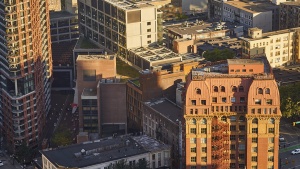Richmond taxpayers may have to absorb the cost of repairs made to the roof of the Richmond Olympic Oval.
Vancouver
Richmond taxpayers may have to absorb the cost overrun incurred from repairs that are required after moisture spoiled the nearly completed roof at the Richmond Olympic Oval.
Fungi and algae have developed in a portion of the roof membrane system at the Olympic speed skating oval.
After cutting out one-by-one-foot sample pieces on the roof, the city determined that fungi and algae are growing on the organic facer of the IsoBoard insulation, which is the bottom layer of insulation.
The roof membrane system is made up of two layers of insulation and a protective membrane, which was installed on top of two layers of plywood. The plywood and the roof membrane system cover and protect the building’s wood roof panels.
“The plywood got saturated from being on the roof and exposed to the weather. Everybody knew that. The question is: Whose system broke down?” said Greg Scott, Richmond’s director of major projects.
Scott said the city may have already hired experts to do an assessment, which will take a few months.
Replacement costs are being covered by the City of Richmond, the oval’s owner, and are estimated to reach $2.2 million.
However, the city wants to recover the replacement costs and is prepared to take legal action, but cost recovery may prove to be difficult because the roof may not have adequate warranty coverage.
“There is no insurance for this and the manufacturer’s warranty does not apply,” said Scott.
“Everybody involved will get scientists and experts to determine how [algae and fungi] got in there. There are a lot of different ways this could have happened, so I will not make any judgment.”
Scott said a tarp system was used to protect the wood panels and the roof during installation, and that each panel was checked for moisture before the roof’s surface material was applied.
However, some people have said the panels were exposed to water while stored on and off site, and after they were installed.
“The wood panels were stacked three high and had a white plastic cover. The covers were blown off and these things sat exposed to inclement weather for 9 months,” said Derek Barrett, a Richmond taxpayer, who lives near the oval and walks by the construction site six times a week.
“All it would have taken was to put a tarp over the panels.”
He said he wasn’t happy with the way the panels were left outside.
Jim Watson, technical manager with the Roofing Contractors Association of B.C. (RCABC) said the original specification for the roof quote asked for a Roofing Contractors Association Guarantee Corp. (RGC) 10 year guarantee.
However, Flynn Canada was asked to eliminate the guarantee in the value engineering process before the job started.
Despite this elimination, Scott said the guarantee would have done nothing to help the city with the fungi and algae problem.
“Knowing the product (10 year guarantee) and how much it would cost, we decided not to use it. We looked at the value for the expenditure and did not see a quarter of a million dollars value there,” he said.










Recent Comments
comments for this post are closed